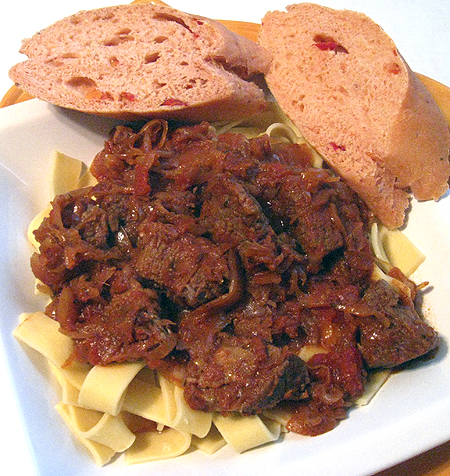
Beef Gulyas, from the book Cooking Jewish, served with a couple
slices of handmade & fresh Tomato Garlic Bread from the Frog Leg
Inn in Erie, Michigan.
When you hear the word “goulash” you probably think of that combination of cooked elbow macaroni mixed with stewed tomatoes, chopped onion and green bell pepper, all seasoned with a powdered savory paprika.
That’s nothing more than an Americanized version of something totally unlike what it should be.
Of course I’ve made American Beef Goulash over the years and will continue to do so. It’s simple and easy, especially on a cold winter’s day when a good comfort food is necessary to warm the bones.
However, when I have both the opportunity and the time, I’ll be making this authentic, slow-cooked Beef Gulyas recipe from the book Cooking Jewish, by Judy Bart Kancigor. At the beginning of the chapter on Meats she explains there’s a reason for slow-cooking in Jewish kitchens:
Because kosher cuts of meat come from the fore section of the animal and not from the more tender (and more expensive) rear, most Jewish recipes favor slow cooking, which tenderizes the meat and makes it succulent, infusing delicious flavors along with the braising liquid.
Partway through the cooking process last night Chef Tad of the Frog Leg Inn in Erie showed up with a fresh loaf of the beautiful Tomato Garlic Bread he’s been making there for special events since November, along with a loaf of the restaurant’s signature bread. In tasting the gulyas for a final seasoning he and I found a great balance of flavors, with the dill rendering a much more pleasant experience than we’d expected.
Later, when I served this to Mary and Aaron, we really couldn’t get enough of it. Slow-cooked, the meat just falls apart when bitten into. The sweet Hungarian paprika adds an incredible flavor which, when combined with the caraway seeds, sauerkraut and dill, creates a hearty richness all of us enjoyed.
A few changes we made: We don’t own a garlic press, so the garlic cloves were crushed under the side of a good chef’s knife and then minced. (No, don’t you dare use that jarred minced garlic in this!) We like the flavor of real sauerkraut, consisting of cabbage, water and salt, with no vinegar added, so we used the SilverFleece brand from Hirzel in Toledo. The tomatoes we used were Dei Fratelli diced in hearty sauce, which are also from the folks at Hirzel. We compromised between the chicken stock, which references a recipe in the book, and store-bought chicken broth, and instead bought some Kitchen Basics chicken stock simply because stock is so much more flavorful. And of course the noodles were the same handmade Amish ones I use in my Traditional Chicken Noodle Soup, the extra wide noodles from Das Dutchman Essenhaus in Middlebury, Indiana.
Finally, a little info: we used PÃPA Sweet Hungarian Paprika (available at Kroger) when preparing this dish.
Beef Gulyas
from Alice Weiss
| *Excerpted from Cooking Jewish Copyright © 2007 by Judy Kancigor Used by permission of Workman Publishing Co., Inc., New York All Rights Reserved |
Traditional Hungarian fare from Aunt Sylvia’s cousin, this is goulash with tangy sauerkraut. Plain old paprika won’t do here – get yourself a tin of sweet Hungarian paprika, which is so much more flavorful. We prefer to go heavy on the caraway seeds but add as much (or as little) as you’d like.
Serves 6, medium difficulty
1/2 cup vegetable oil, chicken fat or solid vegetable shortening
3 large onions, chopped
3 large cloves garlic, crushed
2-1/2 to 3 pounds beef stew meat, cut into 1-1/2 inch cubes and patted dry
2 to 3 tablespoons sweet Hungarian paprika
1 to 2 tablespoons caraway seeds
1 can (28 ounces) crushed tomatoes in puree
1 pound sauerkraut, rinsed well and drained
1-3/4 cups homemade chicken stock (page 63) or 1 can (14-1/2 ounces) low-sodium chicken broth
2 teaspoons dried dill
1-1/2 teaspoons Kosher (coarse) salt, or to taste
1/2 teaspoon freshly ground black pepper, or to taste
Hot cooked wide noodles, for serving
1. Heat the oil in a Dutch oven or other large, heavy pot over medium heat. Add the onions and cook, stirring occasionaly, until soft, about 10 minutes. Stir in the garlic and cook, stirring occasionally, for about 1 minute more.
2. Add the beef and brown it well on all sides along with the onions, about 10 minutes.
3. Stir in the paprika and caraway seeds, mixing well. Add the tomatoes. sauerkraut, chicken broth, dill, 1 teaspoon of the salt, and 1/4 teaspoon of the pepper. Simmer, covered, for 1-1/2 hours.
4. Add the remaining 1/2 teaspoon salt and 1/4 teaspoon pepper, cover, and continue coking until the beef is tender, 30 to 60 minutes.
5. Serve the goulash over hot noodles.